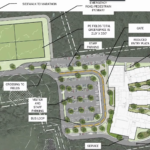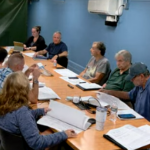The Conservation Commission at its 90-minute meeting Tuesday night unanimously approved a request by the Department of Public Works for an 8-foot winter drawdown of Lake Maspenock for two weeks as a strategy to control invasive weed growth.
Last month, the commission approved an initial standard drawdown of the lake to gauge its effectiveness in curbing weed growth. However, the commission did not approve a more extensive drawdown request at that time because supporting documents were received the day of the meeting and it did not have time to review them beforehand.. The documents included feedback from town consultant and certified limnologist David Mitchell.
Previously, the DPW would draw down the lake to either 5 or 8 feet every three years as part of the operational maintenance plan for the dam. This type of work typically is performed in late September to early October.
Member Ted Barker-Hook asked DPW Director John Westerling if the drawdown period could be extended “to give it a better chance to kill weeds” without hindering the timeline for the refill.
Westerling indicated the last time an 8-foot drawdown was performed two years ago, an extension was granted because the weather did not cooperate.
“But I think we also extended it five years ago when it was extremely effective and had the best weed kill,” he added.
The issue of potentially using herbicides to kill invasive weeds has stirred debate in town for months. While some residents claimed the weeds were a hazard to swimmers, others argued that the weeds were more of a nuisance. There were suggestions for other methods of weed control in a “toolbox” of strategies, and the drawdown was one of them.
Residential tree removal issue addressed
The other major issue the commission discussed involved a cease and desist order for tree clearing at 56 Downey Street, which abuts Lake Maspenock.
Conservation Administrator Kim Ciaramicoli explained that the new property owner intends to raze the house there and requested permission to remove the trees down to the lake.
“The buffer zone extends and just kisses his existing deck,” she said, noting the trees are under the commission’s purview.
While approximately half of the trees “were either deceased or in immediate danger of striking the house,” Ciaramicoli noted that the other half were viable and were in the buffer zone or just on the bank, and she explained that to the property owner.
A problem arose early last week when a tree removal company was on the property.
“The tree contractor was under the impression that they were just cutting everything down to the bank,” Ciaramicoli said. “So we weren’t able to stop them before they got to the bank. They did get to a few of the other trees that had not been approved.”
This prompted Ciaramicoli to issue the cease and desist order and seek the commission’s advice. Co-Vice Chair Melissa Recos suggested that new trees be planted to replace the ones that were wrongfully removed.
A new house is proposed on the site once the old one has been razed, the construction of which could impact the buffer zone, noted chair Jeff Barnes. He suggested that an enforcement and restoration order be approved so that the wrongfully cut trees could be replaced with “trees of substance.”
Ciaramicoli pointed out that construction outside the buffer zone would not be under the commission’s jurisdiction.
“If the work results in sedimentation into the commission’s jurisdiction, then the commission can take jurisdiction over that work,” Ciaramicoli explained.
“I’m wondering what a cease and desist order does if they’ve already chopped down all of the trees they were allowed to chop down,” Barker-Hook said. He feared that the applicant got “bonus trees” removed without a penalty.
Ciaramicoli noted that some trees were saved by stopping the activity near the bank.
She proposed clustering the new trees near the bank to firm it up and strengthen the buffer strip. This would also protect the homeowner from the new trees growing to a point where they could potentially damage the home. She also suggested filing a request for determination of applicability (RDA) to be filed by the applicant. The commission members agreed to these terms.
The tree removal company will be sent a letter stating that “the commission prefers to have them have the approval in hand before they do the work,” he added. There must be two trees planted for each wrongfully removed tree.
“I guess a lesson’s learned on this one,” Barnes said. “It’s easier to ask for forgiveness than to beg for permission.”
New signage for permanent immovable barriers discussed
Member Jim Ciriello led a discussion on improved signage regarding permanent immovable barriers, or PIBs. He said he believed the current signs and medallions are too small and are often ignored.
He asked for more explicit language on new signage as well, such as, “No cutting.”
“I’d like to get a little firmer with people,” Ciriello said.
Currently, Ciaramicoli said the Conservation Commission does not issue the signs. They are purchased by a local construction company, which then sells them to people at cost. She suggested that the commission design and issue its own signs and offer them to developers at cost, which the commission members approved. The commission will consider potential designs at the next meeting on Nov. 1.






















0 Comments